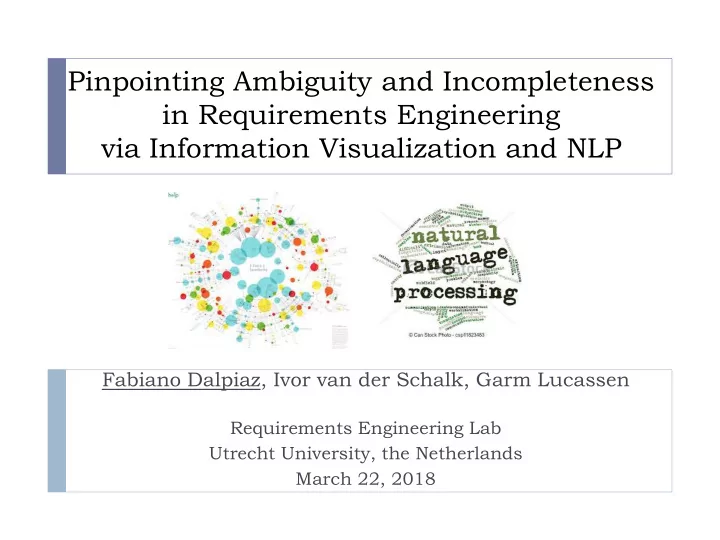

Pinpointing Ambiguity and Incompleteness in Requirements Engineering via Information Visualization and NLP Fabiano Dalpiaz, Ivor van der Schalk, Garm Lucassen Requirements Engineering Lab Utrecht University, the Netherlands March 22, 2018
1. Context and Motivation 2 @2018 Fabiano Dalpiaz
1. Context and Motivation Requirements defects are still present in practice Ambiguity, vagueness, incompleteness, etc. The system shall send a message to the receiver, and it provides an acknowledge message within some seconds [Rosadini 2017] [Vogelsang 2016] 3 @2018 Fabiano Dalpiaz
1. Context and Motivation Requirements defects are still present in practice Ambiguity, vagueness, incompleteness, etc. The system shall send a message to the receiver, and it provides an acknowledge message within some seconds Referential pronoun ambiguity Vague term [Rosadini 2017] [Vogelsang 2016] 4 @2018 Fabiano Dalpiaz
1. Context and Motivation Identifying requirements defects is still hard! Natural language processing (NLP) tools do not deliver perfect accuracy in automated defect identification Human analysts are effective, but how do they scale? [Rosadini 2017] [Tjong 2013] [Vogelsang 2016] 5 @2018 Fabiano Dalpiaz
2. Conceptual Solution 6 @2018 Fabiano Dalpiaz
2. Conceptual solution Requirements artifact: user stories Highly popular in As a student, agile dev! I want to receive my grades via e-mail, [Lucassen 2016] so that I can quickly check them. Idea: combine NLP with information visualization (InfoVis) automation to help humans! Human analyst NLP InfoVis 7 @2018 Fabiano Dalpiaz
2. Conceptual solution Different stakeholders have their own viewpoints We focus on differences in their terminology! For example, do car and automobile have the same meaning? 1 is the denotation of term 𝑢 according to viewpoint 𝑊 𝑢 𝑊 1 𝑑𝑏𝑠 𝑊 𝐺𝑏𝑐𝑗𝑏𝑜𝑝 𝑑𝑏𝑠 𝑊 𝑢𝑠𝑏𝑗𝑜 𝑓𝑜𝑗𝑜𝑓𝑓𝑠 8 @2018 Fabiano Dalpiaz
2. Conceptual solution We identify possible defects depending on the denotations that the viewpoints associate with a term 9 @2018 Fabiano Dalpiaz
3. (Near-)Synonymy Detection 10 @2018 Fabiano Dalpiaz
3. (Near-)Synonymy Detection Goal: identifying possible inter-view ambiguity How? We use Semantic Folding Theory (SFT) Every term is associated a semantic fingerprint Such fingerprints are created by analyzing huge amounts of text Similar fingerprints indicate similar terms 11 @2018 Fabiano Dalpiaz
3. (Near-)Synonymy Detection How do we apply SFT to requirements engineering? User Story Set US1 Conceptual US2 model of the … terms USn Visual Narrator (Robeer 2015) SFT Near-synonyms, a source of ambiguity 12 @2018 Fabiano Dalpiaz
3. (Near-)Synonymy Detection (Near-)synonymity between two terms t 1 and t 2 A combination of term similarity and context similarity 2/3 term similarity (car-automobile, etc.) 1/3 context similarity: user stories where the terms appear As a user, I want to make a bid for a car, so that … As a visitor, I want to see the automobiles on the market, so that… Weights assessed via a correlation study with humans 13 @2018 Fabiano Dalpiaz
4. InfoVis for Ambiguity and Incompleteness 14 @2018 Fabiano Dalpiaz
4. InfoVis for Ambiguity and Incompleteness NLP cannot (yet?) replace humans! Use InfoVis using Schneiderman’s mantra Overview first, zoom and filter, then details-on-demand Focus mostly on ambiguity and incompleteness 15 @2018 Fabiano Dalpiaz
4. InfoVis for Ambiguity and Incompleteness Viewpoints Terms 16 @2018 Fabiano Dalpiaz
4. InfoVis for Ambiguity and Incompleteness Viewpoints Shared terms Terms 17 @2018 Fabiano Dalpiaz
4. InfoVis for Ambiguity and Incompleteness Possible incompleteness No user stories about Gallery , Section , News Section for roles User and Visitor ? 18 @2018 Fabiano Dalpiaz
4. InfoVis for Ambiguity and Incompleteness Ambiguity level High Medium Low 19 @2018 Fabiano Dalpiaz
4. InfoVis for Ambiguity and Incompleteness Filter Zooming 20 @2018 Fabiano Dalpiaz
5. Quasi-Experiment 21 @2018 Fabiano Dalpiaz
5. Quasi-Experiment Hypothesis: analysts who use our approach obtain a significantly higher… precision in finding ambiguities (H1); recall in finding ambiguities (H2); precision in finding missing requirements (H3); recall in finding missing requirements (H4); …compared to analysts using a pen-and-paper inspection. 22 @2018 Fabiano Dalpiaz
5. Quasi-Experiment Study purpose/object: compare the relative effectiveness of Our approach (REVV tool) supported by an 84’’ touch screen A manual, pen-and-paper inspection of the requirements With voluntary MSc students in information science (n=8) 2 groups of 2 students with REVV 2 groups of 2 students pen&paper 23 @2018 Fabiano Dalpiaz
5. Quasi-Experiment Constructs were defined through brainstorming among the authors, a pilot test, and the existing literature A missing user story is one whose absence inhibits the realization of at least another user story An ambiguity occurs when two user stories contain distinct terms that shares the same denotations 24 @2018 Fabiano Dalpiaz
5. Quasi-Experiment Quantitative results Reject H1 and H3 (precision) Retain H2 and H4 (recall) 25 @2018 Fabiano Dalpiaz
5. Quasi-Experiment Qualitative findings Different types of interaction with the screen T ool usability should be improved The tool can lead to time savings 26 @2018 Fabiano Dalpiaz
6. Discussion and Outlook 27 @2018 Fabiano Dalpiaz
6. Discussion and outlook A first attempt to combine NLP and InfoVis Focus on ambiguity (near-synonymity) and missing reqs Inspiration by Venn diagrams Future directions Algorithm can be further tuned (risk of overfitting?) Evaluation, evaluation, evaluation! Using domain ontologies for better results? 28 @2018 Fabiano Dalpiaz
Thanks from the Requirements Engineering Lab at Utrecht University! Fabiano Dalpiaz Sjaak Brinkkemper Marcela Ruiz F. Basak Aydemir Sietse Overbeek Gerard Wagenaar Davide D ell’Anna Govert-Jan Slob 29 @2018 Fabiano Dalpiaz
Recommend
More recommend